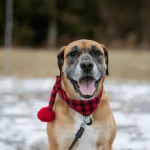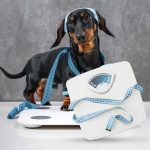Does your dog get scared or stressed when they hear loud noises? This is an easily treatable condition and just needs a little bit of training to ensure your dog feels safe and secure in their home whilst thunderstorms rage and fireworks explode nearby.
 Preparation is the key to getting your dog over their fears. It is suggested that training should begin at least two months prior to the noisier seasons when fireworks and storms are more prevalent. You will need perseverance to reduce the fear, short training sessions should ideally take place up to eight times a week until they show no fear of loud noises. Because all dogs are unique it is important to adapt your training in accordance to their behaviour, but our guide below should accommodate all phobias as long as you are willing and patient.
Preparation is the key to getting your dog over their fears. It is suggested that training should begin at least two months prior to the noisier seasons when fireworks and storms are more prevalent. You will need perseverance to reduce the fear, short training sessions should ideally take place up to eight times a week until they show no fear of loud noises. Because all dogs are unique it is important to adapt your training in accordance to their behaviour, but our guide below should accommodate all phobias as long as you are willing and patient.
Training and Preparation
Create a calm refuge
Make a space just for your dog with a cosy towel or bed which is a place they will only associate with positive calming activities. Keep your dog calm in this area, occasionally praise and give them a treat to reinforce good, placid behaviour.
Install a Dog Appeasing Pheromone (DAP) diffuser in the home, preferably close to your dog’s refuge. DAP diffusers are available from your vet and should be left operating 24 hours a day. They produce a calming atmosphere for your dog and is best to start using a couple of weeks before a known event, like fireworks, as this will create a more powerful relaxing effect.
Desensitisation
Build up your dog’s experience of the sounds that scare them, by exposing them to the sound firstly at a very low volume. You can find specially made recordings of such sounds under the brand name ‘Sounds Scary’. Otherwise you can find all sorts pre-recorded noises online. Spread the speakers apart and put at an elevated level to best mimic a natural event.
Your dog should be in his established ‘safe haven’ when you play the noises as this will help keep their anxiety and fear levels as low as possible.
Play the sound at the lowest volume level, hopefully your dog won’t have a sustained fearful response (note this may not be possible), or a very momentary response (your dog turns toward the source of the noise), or if your dog is very sensitive, it might produce a temporary anxiety response that lasts only a short period of time -10-30 seconds.
Counter-Conditioning
Now, try to change your dog’s perception of noise by associating the low-level sounds with something positive:
Treats: As the noise recording is playing, start to give your dog high-value treats. If it is a continuous sound like rain or wind, give treats consistently. If it is fireworks or thunder, it is best to wait to give a treat until just after the loud bang.
Games: You could also use games as a reward, such as playing ball or tug-of-war if this normally creates a positive response in your dog.
Use of calming commands: If your dog enjoys working, they can be asked to perform commands during the noise recordings.
These techniques should relax your dog and make them feel like it is just an ordinary happy situation.
Reinforcement
If your dog no longer shows any signs of anxiety or fear at a low level of noise, and is willing to engage in another activity (food, games, commands) and has body postures that indicate they are not anxious or fearful, increase the volume on the recording.
Allow your dog 10-30 seconds to get used to the increase in noise before making efforts to engage your dog by giving them treats and doing calm command exercises.
Once your dog seems more relaxed, you can attempt to play a game.
As the training proceeds, the volume of the recording should be increased, based on the individual dog’s behavioural progress, until loud sounds can be played without causing a fear response.
Bear in mind the speed of this progress will be very dependent on your dog’s personal response to noise. Just be patient and remember that your dog responds to your behaviour more than anything; if you are calm and relaxed this should reinforce relaxation in them, so never attempt these techniques whilst in a rush or stressed yourself.
When the Real Noises Start
If you know that a firework display or a noisy stimuli is due on a particular evening, then give your dog a carbohydrate-rich meal before-hand. Pasta, mashed potato or over-cooked rice are ideal and will help to make your dog feel calm and sleepy.
If your vet has given you medication to reduce your dog’s fears, make sure you follow the prescription precisely.
As soon as the noise starts, lead your dog to their safe haven.
Do not get cross with your dog when they’re scared as it will only make them more frightened.
Do not try to soothe your dog to relieve their fears, this can give your dog the impression that there’s something to be frightened of and may even reward them for being scared.
Ignore your dog when they look frightened and only show affection and attention when they have begun to relax.
Try to keep your dog in a happy mood by playing lots of games and doing little bits of training using food rewards.
Ignore the noises yourself and try to appear happy, calm and relaxed.
Make sure your pet is kept in a safe and secure environment at all times so that they don’t bolt and escape if a sudden noise occurs. Keep your dog on a leash in public places and make sure that gates, fences and doors are secure.
As we know it’s not healthy for your pets to be scared and stressed. It’s important as an owner to help them realize that there is nothing to be afraid of. This will make your pet’s world a happier place, keeping both you and your pet relaxed. If you are concerned about your pet’s phobia please feel free to come into the clinic, you don’t need an appointment and our waiting rooms are a calm atmosphere for your pet.





